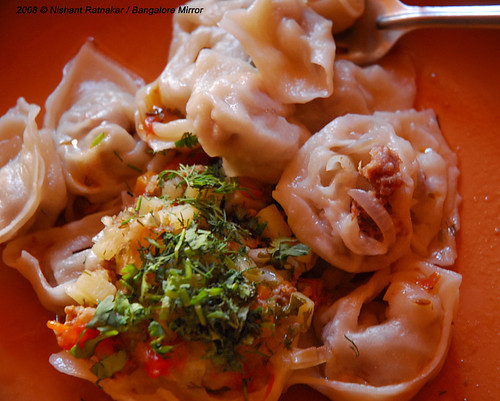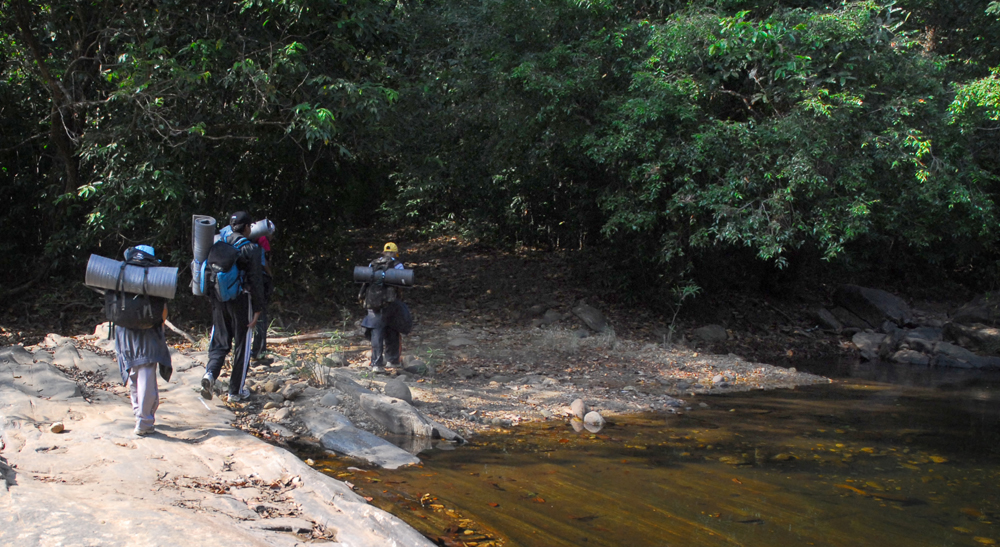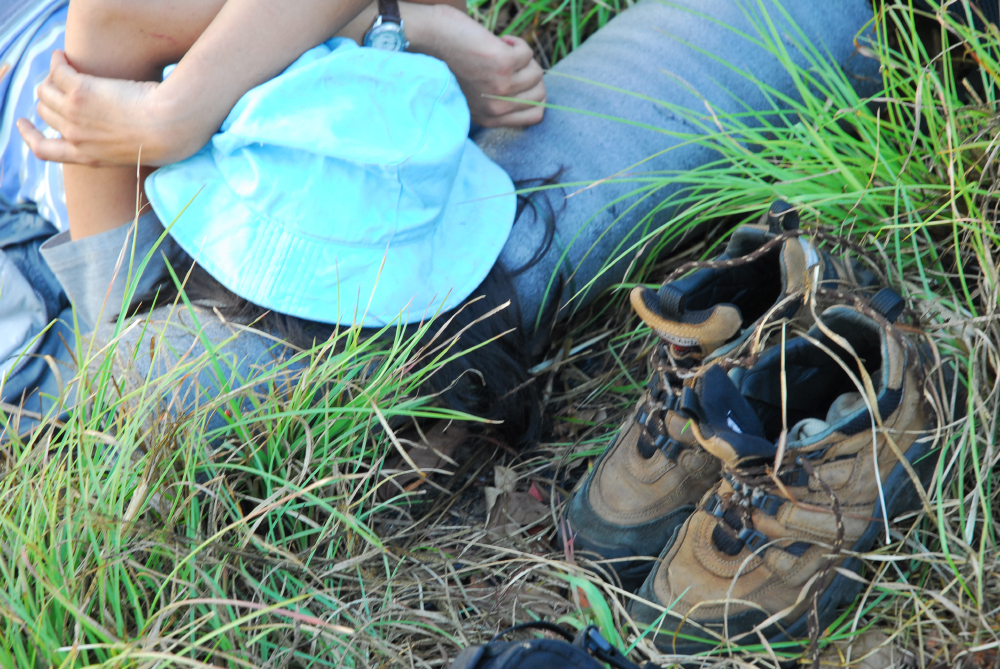From the initial introduction, I realized that they were actually from Uzbekistan and not from Russia as mentioned earlier. Further, the other 'Russian' artists in the troupe were Uzbeks too. They were are all artists from the famous Tashkent Circus in Uzbekistan and were in India on a contract. It is due to Indian audience's continued romanticising of Russian artists since the days of Raj Kapoor's movie, 'Mera Naam Joker', that these artists are labelled as Russian artists by the Indian circuses for business reasons. These artists however no qualms about it as they share a common history with Russia. Uzbekistan and Russia were both part of USSR before its disintegration into separate independent nations.

Alem and Gul were preparing lunch for their mates when I sat about to interview them. They were preparing
Chuchvara, which is flour dumplings stuffed with minced beef meat and is considered to be Uzbekistan's national dish. Gul Sanam is a 27 year old woman who has been in the circus field for the last seven years. She is in India accompanied by her 3 year old daughter, Zyara Baano. Gul along with Alem Jaan and two other Uzbek artists in the troupe are horse riding artists from Tashkent Circus. And the show of this quartet has become quite popular among circus goers in India.
There was a TV playing a Hindi movie in their kitchen. Probably, their learning of Hindi happens by watching television programes. Alem, is a 20 year old man who has been in the circus life for last two years. Prior to being a circus artist he used to be a shopkeeper in a market in Tashkent. It has been a quite switch of career for him from being a shopkeeper in an alley in Uzbekistan to a horse riding artist in India. My attempt at asking Alem if he was married, didn't give me the answer I was hoping for but instead it gave me an insight into the Uzbekistan's cuisine. The word 'Marriage' was unknown to Alem and the closest rhyming word to his ears was the Hindi word '
Mirchi' (Chilly). Alem told me that back in Uzbekistan, they prefer less spicy food and in India he is making attempts to get used to Chillies in everything that is served to him. But Gul understood what my question was, and we had a hearty laugh when she said that Alem was still a '
bachcha' or a kid to get married.
These artists were jovial people and seemed to love Indian culture a lot. A personality trait one would associate with a horse rider from a place like Uzbekistan would be that of a rough and tough warrior from one of the Russian folktales you would have heard off as bed time stories as a child.
Alem was swinging to the tunes of a '
Jab we met' track which I was playing on my laptop. While little
Zyara was glued to my laptop and camera,
Gul told me that she has watched quite a bit of Hindi movies back home. She recollects having watched
Shahruk Khan starrer '
Baazigar', and like many young Indian girls, she confessed that she was a fan of Bollywood heartthrob,
Salmaan Khan. Learning of a foreign language and culture is a long process but slowly these people were blending among the locals. One of the local artists who passed by their tent greeted them by saying 'Hello' to which Gul replied in Indian word '
Namashkaar'.
Coming from a country where 88% of the people are followers of Islam like her, Gul is an example of how liberal the Uzbek society. Nobody questioned her when she chose a profession which is usually considered a man's domain. Even her husband, a horse rider like her, never opposed her decision to be a circus artist and never object her coming to India with their daughter. She indicates that if she ever leave circus she might want to take up a job as a driver or learn computers as she fascinated by cars and computers.

The game of trying to overcome language barriers would have continued for long but we were soon joined by 16 year Ubaidullah, the third member of the quartet who has been in India for a while and could converse in Hindi. Ubaid, as he is fondly referred to, was never interested in studies. He spent a major portion of childhood days playing football. Football is a popular sport in Uzbekistan along with 'Kurash', a wrestling like sport peculiar to this region. Uzbekistan has a strong national football team and Ubaid was no doubt in love with this game. When he was 10 years old, seeing his lack of interest in studies, his father who was a driver in Tashkent circus asked him if wanted to make a living with circus. He then decided to give it a try. On his first visit he instantly fell in love with the horses and since that day he has never looked back. His burning ambition is to be a master in horse riding someday. He told me that intends to go back to Tashkent soon and join the Tashkent Circus College to perfect his skills.
A college for circus! That was something never heard in India. Circus is a respected art in Russia and Uzbekistan. Tashkent and Moscow circuses are some of the most famous circuses of the region. Unlike India where circuses are travelling in nature, these circuses are permanently housed in a location with a with full-fledged infrastructure for artists and animals. The artists from Russia and the new central Asian countries are most sought after by the circuses across the world. And to live up to the legendary reputation, the governments in these countries have set up colleges to train the budding artists before sending them across the world as ambassadors of their art.

Both, Ubaid and Alem have hairdo in copper shade. When asked if it was their natural colour, Ubaid said that actual hair color was black but Indian circus goers associate copper color of hair with a 'Russian artist' and hence they have colored it with that shade. This generalization in the minds of the masses can again be attributed to the Hindi film, 'Mera Naam Joker'. It was surprising to hear that the movie was very popular in Uzbekistan. Ubaid said that, back home he has a video disc of this movie and he has watched it nearly a hundred times! Ubaid loves Raj Kapoor's role in the movie and tells that a popular belief in Uzbekistan which makes the movie popular, is that a lot of Uzbek actors have played minute roles in that movie.
Ubaid is very much like any India boy of his age. He loves computer games and gadgets. Seeing my laptop he was curious to know if there were any games in it. I more than happy to lend my laptop to him for a round of virtual pinball game while clicked photographs of him and his troupe. Ubaid loved performing in Kerala the whole of last year.He says he liked the places like Kannur,kollam and trivandrum. Last time he had purchased sarees for his mother. This time from Bangalore he plans to buy lot of gifts for his family back home. Mobile phone for his dad and an MP3 players for his brothers are top of his shopping list.
Ubaid shared his experience of training to be a horse rider. For a year his master would have a '
lonja' , a long rope whose end would be tied around his waist while the other end was in his master's hand. Ubaid used to ride the horse in circles while the
lonja would ensure his safety from fatal falls. He remembers having fallen quite a few times but he was lucky enough to escape with few bruises. Alem and Gul too had similar experiences while they studied at Tashkent circus.

We were later joined by Sanjaar, the fourth member of the quartet of Uzbek horsemen and along with him was their group manager in India. People were referring to their manager as
Bahadur and hence I mistook him to be a Nepali. He told me that his actual name was
Eshmatov Bahodir Batirovich and people in India began calling him by his middle name which was rhyming with hindu name Bahadur. Hence for the last four years people in Indian circus scene know him as Bahadur. Bahodir is the only member of the team who can speak English. Bahodir's origins too is attributed to Tashkent circus where his uncle is a director. He initially had a office job in circus and after few years he was offered the job to be a group director for the troupe which was sent to India.

Bahodir gave an insight to how and why the artists from Uzbekistan come to India. He said, "Tashkent circus is owned by the government of Uzbekistan. The circus there does not run for huge collections by ticket sales. Its a permanent circus and circus is a revered art in Uzbek and Russian culture. The government gets invites from circuses outside their country for artists to perform in their locations. It is the government which takes the call and provides opportunities for artists from Tashkent circus to travel to outside circuses. The main reasons for artists to perform in foreign countries is not money as most people mistake it to be so. Its or the fame and experience that one gets to boast of. In our region a circus artist is respected for his experience in number of years of performances and also for the places he has travelled to. The preferred destination for artists is Japan and Monte Carlo. Then come India and China". He further adds, "Every artist from Uzbekistan will have to study through Tashkent Circus. They put in 2 to 4 years of training there and after which they get absorbed into Tashkent circus. In the circus they are put under care of mentors who observe their work and decide when they can start performing on their own. Tashkent and Moscow circuses can be called as factory circuses. They produce artists and also create new types of shows for the world circus".
According to Bahodir, the reason for popularity of horsemen from their region is because one of the founders of Tashkent Circus was a horseman. Also, the Almata horses from central asia are one of the most expensive and fast horses in the world. The almata horses could be priced anywhere close to 10,000 US dollars and are in demand worldwide. Hence, in demand are these brave horsemen who have experience of riding almata horses.
Bahodir, is married to a Lasso artist (another circus art) from Uzbekistan. His wife is a christian while he is a Muslim. He reiterates that Uzbek society is one of the liberal societies of the world. There will not be much of fuss when there is any inter-religious marriage. He cheekily adds on that when his children grow up they are free to marry anyone. They can marry a Muslim or a christian, or even a Hindu. Bahodir has spent 4 years in India bringing in managing new group artists from Uzbekistan every now and then. He says that there have been many memorable experiences in this country which he will take back with him. He loved small towns and villages of India than big cities. And he is sure that his horsemen will have a great time in India too.
While Uzbek artists went to put on the costumes for their show, I was hosted by Bahodir for lunch. I was treated with a plate of
Chuchvara, which Alem and Gul had prepared while i was interviewing them. I must add that the Uzbek horse riders are not just good artists, but also good cooks.


 These stories about Ombattu udda excited me and five of my techie friends to plan for a weekend trek to Ombattu Gudda. Armed with a GPS (Global Positioning System) device, a hand drawn map and our rations for the two-day trek we set off in conquest of Ombattu Gudda.
These stories about Ombattu udda excited me and five of my techie friends to plan for a weekend trek to Ombattu Gudda. Armed with a GPS (Global Positioning System) device, a hand drawn map and our rations for the two-day trek we set off in conquest of Ombattu Gudda. The road from Sakleshpur to Gundya — the infamous Shirdi Ghat highway — might as well be on the moon, if only for the craters! And the car we were in, hit a huge stone slab head-on but continued for two hours to Gundya. After a tea break around 6:15 am, we began our trek. The initial phase of the trek was easy with a clearly laid out path through the forest cutting across many small streams. Elephant dung dotted the entire path. We kept a lookout for the herd all set to sprint in the opposite direction. The path runs close to Kabbinale river.
The road from Sakleshpur to Gundya — the infamous Shirdi Ghat highway — might as well be on the moon, if only for the craters! And the car we were in, hit a huge stone slab head-on but continued for two hours to Gundya. After a tea break around 6:15 am, we began our trek. The initial phase of the trek was easy with a clearly laid out path through the forest cutting across many small streams. Elephant dung dotted the entire path. We kept a lookout for the herd all set to sprint in the opposite direction. The path runs close to Kabbinale river.
 opy of trees. We finally realised that we were lost! After long discussions, we decided to continue the trek to the summit. So we went ahead making our way through bamboo massacre sites, the work of wild elephants. Every now and then, fresh elephant dung got us on our toes, as did the venomous viper that hissed past us. We pushed ourselves on.
opy of trees. We finally realised that we were lost! After long discussions, we decided to continue the trek to the summit. So we went ahead making our way through bamboo massacre sites, the work of wild elephants. Every now and then, fresh elephant dung got us on our toes, as did the venomous viper that hissed past us. We pushed ourselves on. t would have been very dangerous. We took regular breaks to rest our bodies, which were on verge of dehydration due to limited water supply. After hours of climbing uphill, we finally saw the grasslands of Ombattu Gudda. We had trekked nearly 15 kms in a single day.
t would have been very dangerous. We took regular breaks to rest our bodies, which were on verge of dehydration due to limited water supply. After hours of climbing uphill, we finally saw the grasslands of Ombattu Gudda. We had trekked nearly 15 kms in a single day.
 The next morning, we trekked over the nine humps for three kilometres, and made it to the peak of Ombattu Gudda. It was a moment of accomplishment for the six of us. We had joined the exclusive club of successful Ombattu Gudda trekkers.
The next morning, we trekked over the nine humps for three kilometres, and made it to the peak of Ombattu Gudda. It was a moment of accomplishment for the six of us. We had joined the exclusive club of successful Ombattu Gudda trekkers.









